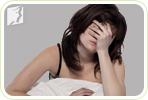During menopause, the constant fluctuation of your hormones - estrogen in particular - can create all sorts of problems in the body manifesting in some unpleasant physical and mental side effects.

Melatonin is a hormone produced in the brain that is in charge of regulating your body. It's levels are generally highest before you go to sleep. Melatonin production is stimulated by darkness, while bright, artificial light has the opposite effect. Because of the chemistry between melatonin and fluctuating estrogen, a menopausal woman may experience an array of sleeping pattern problems.
Common characteristics of a sleeping disorder are:
- Requiring more than 30 minutes to fall asleep
- Problems with memory and concentration
- Snoring
- Sleepwalking
- Waking up several times throughout the night
Read more about how to recognize menopausal sleep disorders
Insomnia

Insomnia is defined as the consistent inadequate sleep levels resulting from one of the conditions listed above. Nearly 17% of the world's population suffers from insomnia and many of them are women with menopause. Menopausal women may have trouble sleeping because of a combination of their other menopause symptoms such as night sweats and anxiety.
Sleep Apnea

Sleep apnea occurs when a person air flow has stopped briefly during sleep. Sleep apnea occurs when a person's air flow is blocked briefly during sleep. There are many subtypes of this sleeping disorder that are common among adults. Sleep apnea can also lead to more serious health concerns, and can increase the risk of:
- High blood pressure
- Insulin resistance, which can affect progesterone production
- Heart conditions
Restless Leg Syndrome (RLS)

Restless leg syndrome is characterized by feelings of uneasiness while sitting or lying. RLS is characterized by feelings of uneasiness while sitting or lying and an urge to move your legs. You may also feel RLS in other limbs, as the condition can affect other parts of the body. RLS tends to be worse for people at night, but may completely disappear in early morning.
Narcolepsy

Narcolepsy is a disease of the central nervous system.Narcolepsy is a disease of the central nervous system. It is not as common as some of the other sleep disorders, but may be one of the most well-known. Symptoms of narcolepsy include cataplexy or the sudden loss of muscle control, hallucinations, and the temporary inability to move when transitioning from asleep to awake.
More Information on Sleep Disorders
Sleep is one of the most important components of optimum health. Sleep is the time when the brain and body can rest, and without proper rest, your body will not function as it should. Your inadequate sleep may be due to an unhealthy diet or some other lifestyle choice. Read more about sleeping disorders treatments.
Sources
- Breus, Michael.(n.d). "Menopause and Sleep".Retrieved from MedicineNet.
- Love, Susan M.D. Menopause and Hormone Book. New York: Three Rivers Press, 2003.
- Walsleben, Joyce M.D. "Ask the sleep expert: menopause and insomnia". National Sleep Foundation.
- "Your Guide to Healthy Sleep". National Institute of Health, April 2006.



